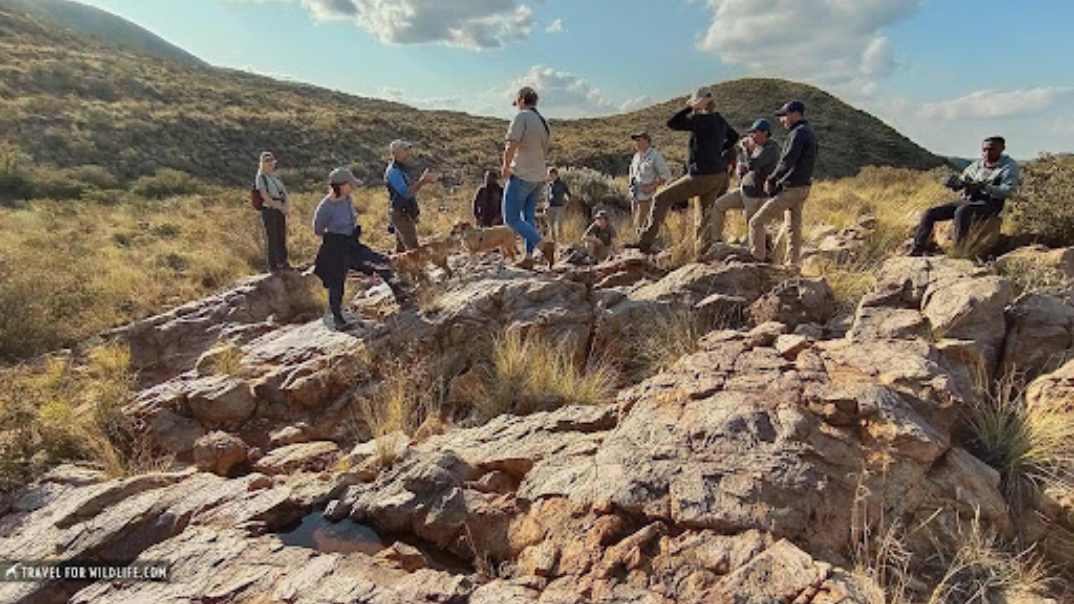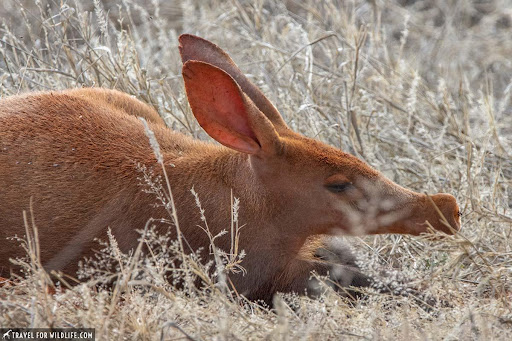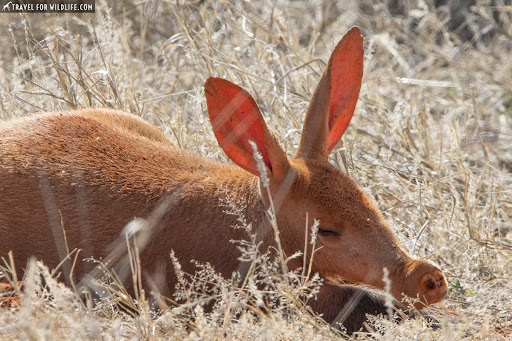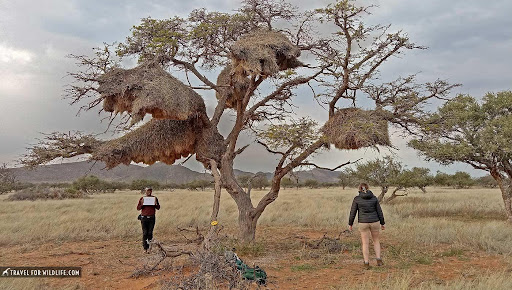 By Hal Brindley (Travel For Wildlife https://travel4wildlife.com)
By Hal Brindley (Travel For Wildlife https://travel4wildlife.com)
It was with a strange mix of emotions that I laid eyes upon the bizarre creature. Seconds earlier I had leapt from inside of the Suzuki Vitara, eyes wide and trying in vain to stay calm and quiet. It was an animal I had always dreamt of seeing but never quite believed I would. I was watching an aardvark. And it was only our first day in Tswalu Kalahari Reserve.

A dream come true, watching an aardvark in the Kalahari.
Tswalu is a private game reserve in South Africa and sits in my favorite African ecosystem: the Kalahari. It’s also one of the few places in the world where you have a good chance of seeing an aardvark in the wild. It’s no wonder I’ve been fantasizing about coming here for over a decade. But how would I ever pull that off? Most visitors come in through the front door as a guest to the luxurious lodge (with an appropriately matched price tag) and experience an unparalleled safari adventure. But considering my lifelong policy of avoiding employment, this was unlikely to happen.

Tswalu is a great place to see other rare and elusive mammals like this brown hyena, spotted on an afternoon hike.
Instead, I chose the secret back entrance. Tswalu has a full-blown research camp on the property and houses scientists from around the world who study the Kalahari ecosystem. I developed a brilliantly simple plan. All I had to do was convince a top-notch university to accept me into a biology Master’s program, pay my tuition, leave my wife and cat behind in the US, travel to South Africa, rent a flat, attend seven months of classes, and survive long enough to reach the Community Ecology module which would take me on a one-week field trip to Tswalu.

Students learning about the Kalahari ecosystem, hosted by the Tswalu Foundation
My plan went off without a hitch. Now I was standing in the red sand beside my 13 fellow students of the University of Cape Town’s Conservation Biology class, watching the very animal I most wanted to see. Our intrepid professor, Dr. Robert Thomson, is a member of the Kalahari Endangered Ecosystem Project (KEEP), supported by Suzuki SA and the Tswalu Foundation. This meant we had access to a small fleet of Suzuki vehicles to carry out our field work on the reserve. For months I had been driving a bright blue Suzuki S-Presso rental and had fallen in love with it. Now I was on the hunt for a vehicle for the research phase of my degree. The Suzuki Vitara I drove at Tswalu was surprisingly adept on the deeply rutted sand dunes and made my list. I hoped to try the project’s new Jimny next but Robert kept hogging it.

Conservation biology student Bruce Chrispo from Tanzania, takes a moment to enjoy the Kalahari dunes next to the KEEP Jimny.
We peered quietly over vehicles and out of windows and the aardvark seemed utterly unfazed by our presence. The strange features settled upon me one by one: the long jack-rabbit ears, the stocky body with a big round rear end, the coarse hairs tinged a deep rusty red. She was larger than a Labrador retriever but could dig herself under the ground in less than ten minutes. Then she lifted her head to reveal her most endearing trademark: a long anteater-like snout with a perfect pig nose plastered to the end. I was so entranced that I almost forgot the true objective of our visit. Then a large mass in a distant camelthorn tree brought me back. It was an impressive sociable weaver nest.

An aardvark raises her head from a sunny afternoon nap on a chilly winter day in Tswalu.
We were assisting KEEP in their study of sociable weavers and how their massive colonial nests impacted other species. Some of these nest structures housed hundreds of birds and were far larger than the Suzuki S-Presso I’d been driving. Prior research had already found sociable weaver nest trees to be biodiversity hotspots in the Kalahari, providing refuge and resources to skinks and snakes, many species of birds from acacia pied barbets to spotted eagle-owls, and a diversity of mammals from mongoose to cheetah. This earned sociable weavers the admirable title of ecosystem engineer.

Student Bruce Chrispo from Tanzania and Ella Mutch from the UK studying sociable weaver nests in South Africa.
Robert was the kind of professor who let us absorb, enjoy, and appreciate our surroundings. He allowed us to play tourist while we were learning to be scientists.
The aardvark lounged peacefully for six minutes, an eternity in aardvark-watching time. Finally, she stood and dove into her burrow. To our surprise, she didn’t nap. Instead, clots of red sand began to launch from the opening. We were witnessing another ecosystem engineer in action, a prolific burrower who created homes and habitats for so many other species. I smiled to myself and hoped that one day my own scientific work could be as influential on the lives of Kalahari creatures as were the sociable weaver and the aardvark.
Read more of Hal’s adventures at Travel For Wildlife.com.

![How Things Work: 4x4 Systems [VIDEO]](https://blog.suzukiauto.co.za/hubfs/Untitled%20design%20%2821%29-2.png)
